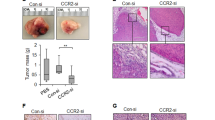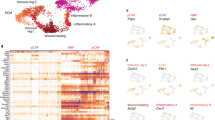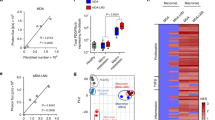Abstract
The migration of cancer cells towards gradients of chemoattractive factors represents a potential, yet elusive, mechanism that may contribute to cancer cell dissemination. Here we provide evidence for the maintenance of a gradient of increasing CCL8 concentration between the epithelium, the stroma and the periphery that is instrumental for breast cancer cells’ dissemination. In response to signals elicited by the neoplastic epithelium, CCL8 production is enhanced in stromal fibroblasts at the tumor margins and in tissues at which breast cancer cells tend to metastasize such as the lungs and the brain. Manipulation of CCL8 activity influences the histology of the tumors and promotes major steps of the metastatic process such as invasion to adjacent stroma, intravasation and ultimately extravasation and seeding. These findings exemplify how gradients of chemoattractive factors such as CCL8, drive metastasis and suggest that interference with their operation may provide means for breast cancer management.
This is a preview of subscription content, access via your institution
Access options
Subscribe to this journal
Receive 50 print issues and online access
$259.00 per year
only $5.18 per issue
Buy this article
- Purchase on Springer Link
- Instant access to full article PDF
Prices may be subject to local taxes which are calculated during checkout






Similar content being viewed by others
References
Vanharanta S, Massague J . Origins of metastatic traits. Cancer Cell 2013; 24: 410–421.
Chatzistamou I, Dioufa N, Trimis G, Sklavounou A, Kittas C, Kiaris H et al. p21/waf1 and smooth-muscle actin alpha expression in stromal fibroblasts of oral cancers. Cell Oncol (Dordr) 2011; 34: 483–488.
Trimis G, Chatzistamou I, Politi K, Kiaris H, Papavassiliou AG . Expression of p21waf1/Cip1 in stromal fibroblasts of primary breast tumors. Hum Mol Genet 2008; 17: 3596–3600.
Lu H, Clauser KR, Tam WL, Frose J, Ye X, Eaton EN et al. A breast cancer stem cell niche supported by juxtacrine signalling from monocytes and macrophages. Nat Cell Biol 2014; 16: 1105–1117.
Su S, Liu Q, Chen J, Chen F, He C, Huang D et al. A positive feedback loop between mesenchymal-like cancer cells and macrophages is essential to breast cancer metastasis. Cancer Cell 2014; 25: 605–620.
Condeelis J, Pollard JW . Macrophages: obligate partners for tumor cell migration, invasion, and metastasis. Cell 2006; 124: 263–266.
Allavena P, Sica A, Solinas G, Porta C, Mantovani A . The inflammatory micro-environment in tumor progression: the role of tumor-associated macrophages. Crit Rev Oncol Hematol 2008; 66: 1–9.
Thiery JP . Epithelial-mesenchymal transitions in tumour progression. Nat Rev Cancer 2002; 2: 442–454.
Muller A, Homey B, Soto H, Ge N, Catron D, Buchanan ME et al. Involvement of chemokine receptors in breast cancer metastasis. Nature 2001; 410: 50–56.
Das S, Sarrou E, Podgrabinska S, Cassella M, Mungamuri SK, Feirt N et al. Tumor cell entry into the lymph node is controlled by CCL1 chemokine expressed by lymph node lymphatic sinuses. J Exp Med 2013; 210: 1509–1528.
Hollmen M, Roudnicky F, Karaman S, Detmar M . Characterization of macrophage—cancer cell crosstalk in estrogen receptor positive and triple-negative breast cancer. Sci Rep 2015; 5: 9188.
Bae JY, Kim EK, Yang DH, Zhang X, Park YJ, Lee DY et al. Reciprocal interaction between carcinoma-associated fibroblasts and squamous carcinoma cells through interleukin-1alpha induces cancer progression. Neoplasia 2014; 16: 928–938.
Gong W, Howard OM, Turpin JA, Grimm MC, Ueda H, Gray PW et al. Monocyte chemotactic protein-2 activates CCR5 and blocks CD4/CCR5-mediated HIV-1 entry/replication. J Biol Chem 1998; 273: 4289–4292.
Islam SA, Chang DS, Colvin RA, Byrne MH, McCully ML, Moser B et al. Mouse CCL8, a CCR8 agonist, promotes atopic dermatitis by recruiting IL-5+ T(H)2 cells. Nat Immunol 2011; 12: 167–177.
Gong X, Gong W, Kuhns DB, Ben-Baruch A, Howard OM, Wang JM . Monocyte chemotactic protein-2 (MCP-2) uses CCR1 and CCR2B as its functional receptors. J Biol Chem 1997; 272: 11682–11685.
Rajaram M, Li J, Egeblad M, Powers RS . System-wide analysis reveals a complex network of tumor-fibroblast interactions involved in tumorigenicity. PLoS Genet 2013; 9: e1003789.
Torres S, Bartolome RA, Mendes M, Barderas R, Fernandez-Acenero MJ, Pelaez-Garcia A et al. Proteome profiling of cancer-associated fibroblasts identifies novel proinflammatory signatures and prognostic markers for colorectal cancer. Clin Cancer Res 2013; 19: 6006–6019.
Pitteri SJ, Kelly-Spratt KS, Gurley KE, Kennedy J, Buson TB, Chin A et al. Tumor microenvironment-derived proteins dominate the plasma proteome response during breast cancer induction and progression. Cancer Res 2011; 71: 5090–5100.
Barbai T, Fejos Z, Puskas LG, Timar J, Raso E . The importance of microenvironment: the role of CCL8 in metastasis formation of melanoma. Oncotarget 2015; 6: 29111–29128.
Finak G, Bertos N, Pepin F, Sadekova S, Souleimanova M, Zhao H et al. Stromal gene expression predicts clinical outcome in breast cancer. Nat Med 2008; 14: 518–527.
Gyorffy B, Surowiak P, Budczies J, Lanczky A . Online survival analysis software to assess the prognostic value of biomarkers using transcriptomic data in non-small-cell lung cancer. PLoS One 2013; 8: e82241.
Fanti P, Nazareth M, Bucelli R, Mineo M, Gibbs K, Kumin M et al. Estrogen decreases chemokine levels in murine mammary tissue: implications for the regulatory role of MIP-1 alpha and MCP-1/JE in mammary tumor formation. Endocrine 2003; 22: 161–168.
Chavey C, Bibeau F, Gourgou-Bourgade S, Burlinchon S, Boissiere F, Laune D et al. Oestrogen receptor negative breast cancers exhibit high cytokine content. Breast Cancer Res 2007; 9: R15.
Fenner J, Stacer AC, Winterroth F, Johnson TD, Luker KE, Luker GD . Macroscopic stiffness of breast tumors predicts metastasis. Sci Rep 2014; 4: 5512.
Bouquet F, Pal A, Pilones KA, Demaria S, Hann B, Akhurst RJ et al. TGFbeta1 inhibition increases the radiosensitivity of breast cancer cells in vitro and promotes tumor control by radiation in vivo. Clin Cancer Res 2011; 17: 6754–6765.
Van Damme J, Proost P, Lenaerts JP, Opdenakker G . Structural and functional identification of two human, tumor-derived monocyte chemotactic proteins (MCP-2 and MCP-3) belonging to the chemokine family. J Exp Med 1992; 176: 59–65.
Blaszczyk J, Coillie EV, Proost P, Damme JV, Opdenakker G, Bujacz GD et al. Complete crystal structure of monocyte chemotactic protein-2, a CC chemokine that interacts with multiple receptors. Biochemistry 2000; 39: 14075–14081.
Roussos ET, Condeelis JS, Patsialou A . Chemotaxis in cancer. Nat Rev Cancer 2011; 11: 573–587.
Chen J, Yao Y, Gong C, Yu F, Su S, Liu B et al. CCL18 from tumor-associated macrophages promotes breast cancer metastasis via PITPNM3. Cancer Cell 2011; 19: 541–555.
Casey AE, Laster WR Jr, Ross GL . Sustained enhanced growth of carcinoma EO771 in C57 black mice. Proc Soc Exp Biol Med 1951; 77: 358–362.
Skarnes WC, Rosen B, West AP, Koutsourakis M, Bushell W, Iyer V et al. A conditional knockout resource for the genome-wide study of mouse gene function. Nature 2011; 474: 337–342.
Carmeliet P, Jain RK . Angiogenesis in cancer and other diseases. Nature 2000; 407: 249–257.
Rafii S, Avecilla ST, Jin DK . Tumor vasculature address book: identification of stage-specific tumor vessel zip codes by phage display. Cancer Cell 2003; 4: 331–333.
Cristofanilli M, Hayes DF, Budd GT, Ellis MJ, Stopeck A, Reuben JM et al. Circulating tumor cells: a novel prognostic factor for newly diagnosed metastatic breast cancer. J Clin Oncol 2005; 23: 1420–1430.
Riethdorf S, Fritsche H, Muller V, Rau T, Schindlbeck C, Rack B et al. Detection of circulating tumor cells in peripheral blood of patients with metastatic breast cancer: a validation study of the CellSearch system. Clin Cancer Res 2007; 13: 920–928.
Kim MY, Oskarsson T, Acharyya S, Nguyen DX, Zhang XH, Norton L et al. Tumor self-seeding by circulating cancer cells. Cell 2009; 139: 1315–1326.
Hu B, Castillo E, Harewood L, Ostano P, Reymond A, Dummer R et al. Multifocal epithelial tumors and field cancerization from loss of mesenchymal CSL signaling. Cell 2012; 149: 1207–1220.
Pienta KJ, Machiels JP, Schrijvers D, Alekseev B, Shkolnik M, Crabb SJ et al. Phase 2 study of carlumab (CNTO 888), a human monoclonal antibody against CC-chemokine ligand 2 (CCL2), in metastatic castration-resistant prostate cancer. Invest New Drugs 2013; 31: 760–768.
Sandhu SK, Papadopoulos K, Fong PC, Patnaik A, Messiou C, Olmos D et al. A first-in-human, first-in-class, phase I study of carlumab (CNTO 888), a human monoclonal antibody against CC-chemokine ligand 2 in patients with solid tumors. Cancer Chemother Pharmacol 2013; 71: 1041–1050.
Acknowledgements
We thank Professors I Roninson, E Broude and JE Schwarzbauer for useful comments and suggestions, and F Marini for sharing the EO771 cells. This study was supported by a pilot grant 5P30GM103336-02 from NIH.
Author information
Authors and Affiliations
Corresponding author
Ethics declarations
Competing interests
The authors declare no conflict of interest.
Additional information
Supplementary Information accompanies this paper on the Oncogene website
Supplementary information
Rights and permissions
About this article
Cite this article
Farmaki, E., Chatzistamou, I., Kaza, V. et al. A CCL8 gradient drives breast cancer cell dissemination. Oncogene 35, 6309–6318 (2016). https://doi.org/10.1038/onc.2016.161
Received:
Revised:
Accepted:
Published:
Issue Date:
DOI: https://doi.org/10.1038/onc.2016.161
This article is cited by
-
Glucocorticoid treatment influences prostate cancer cell growth and the tumor microenvironment via altered glucocorticoid receptor signaling in prostate fibroblasts
Oncogene (2024)
-
The roles of CC chemokines in response to radiation
Radiation Oncology (2022)
-
Endothelial cell-derived Apelin inhibits tumor growth by altering immune cell localization
Scientific Reports (2021)
-
CCL8 mediates crosstalk between endothelial colony forming cells and triple-negative breast cancer cells through IL-8, aggravating invasion and tumorigenicity
Oncogene (2021)
-
Chemokine signaling in cancer-stroma communications
Journal of Cell Communication and Signaling (2021)



